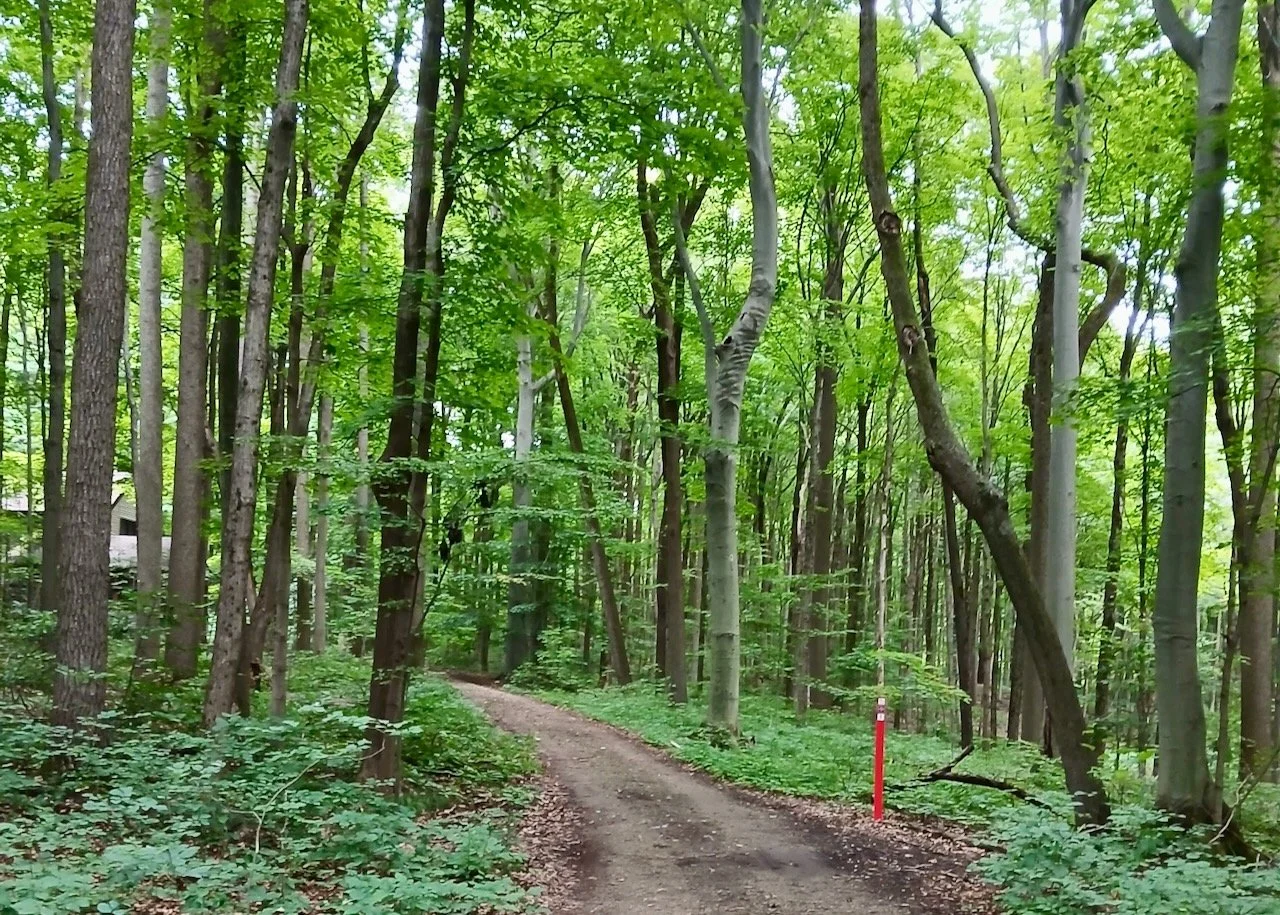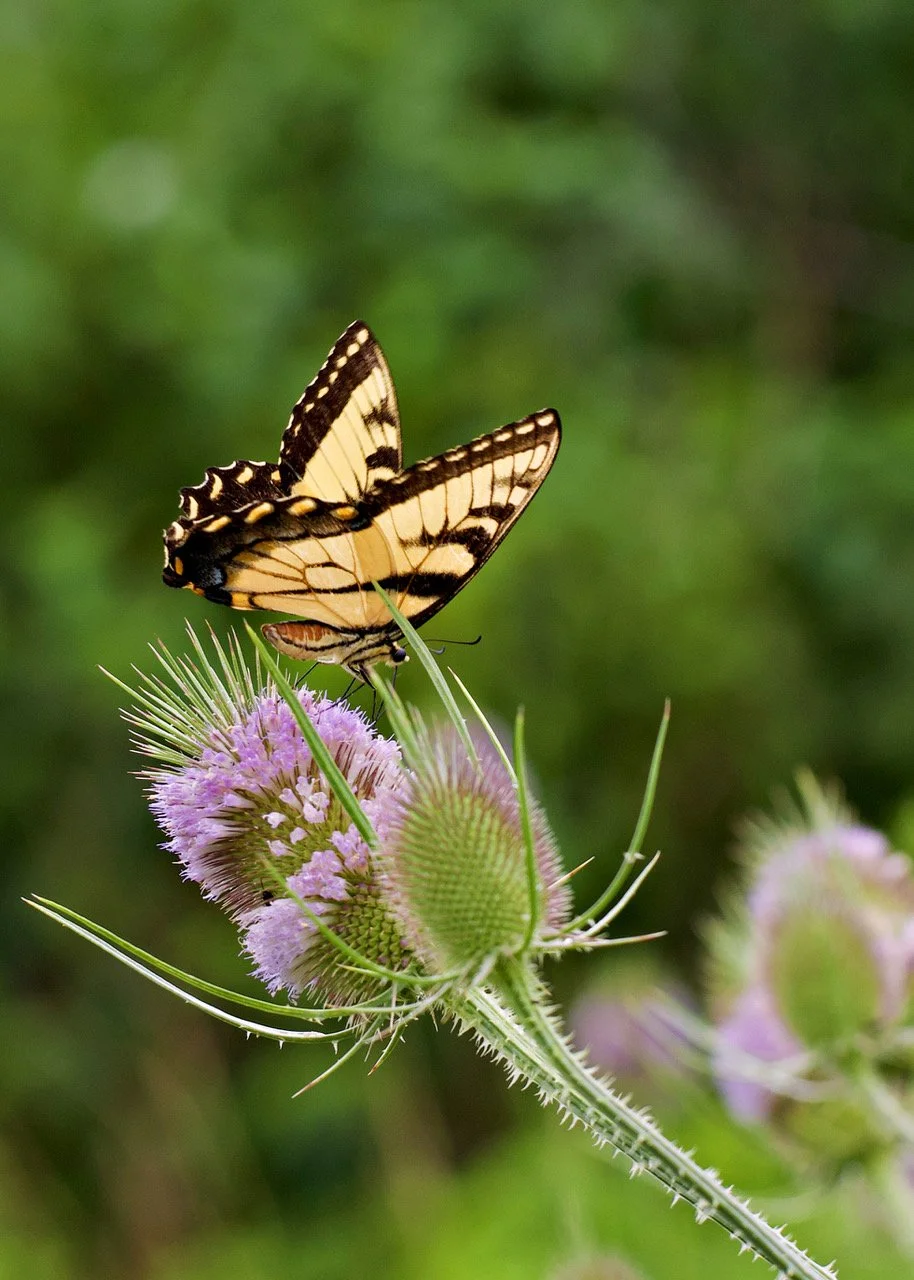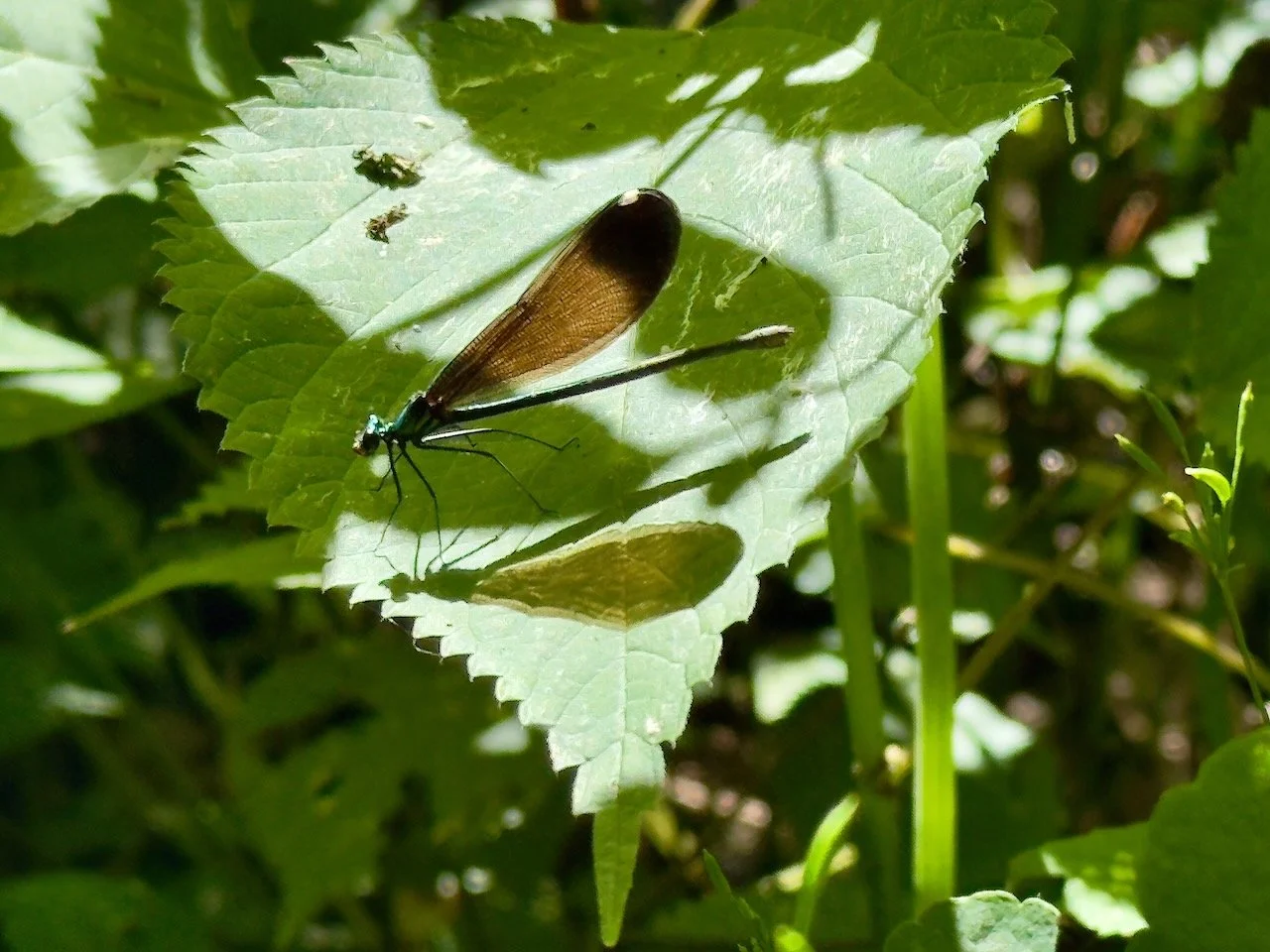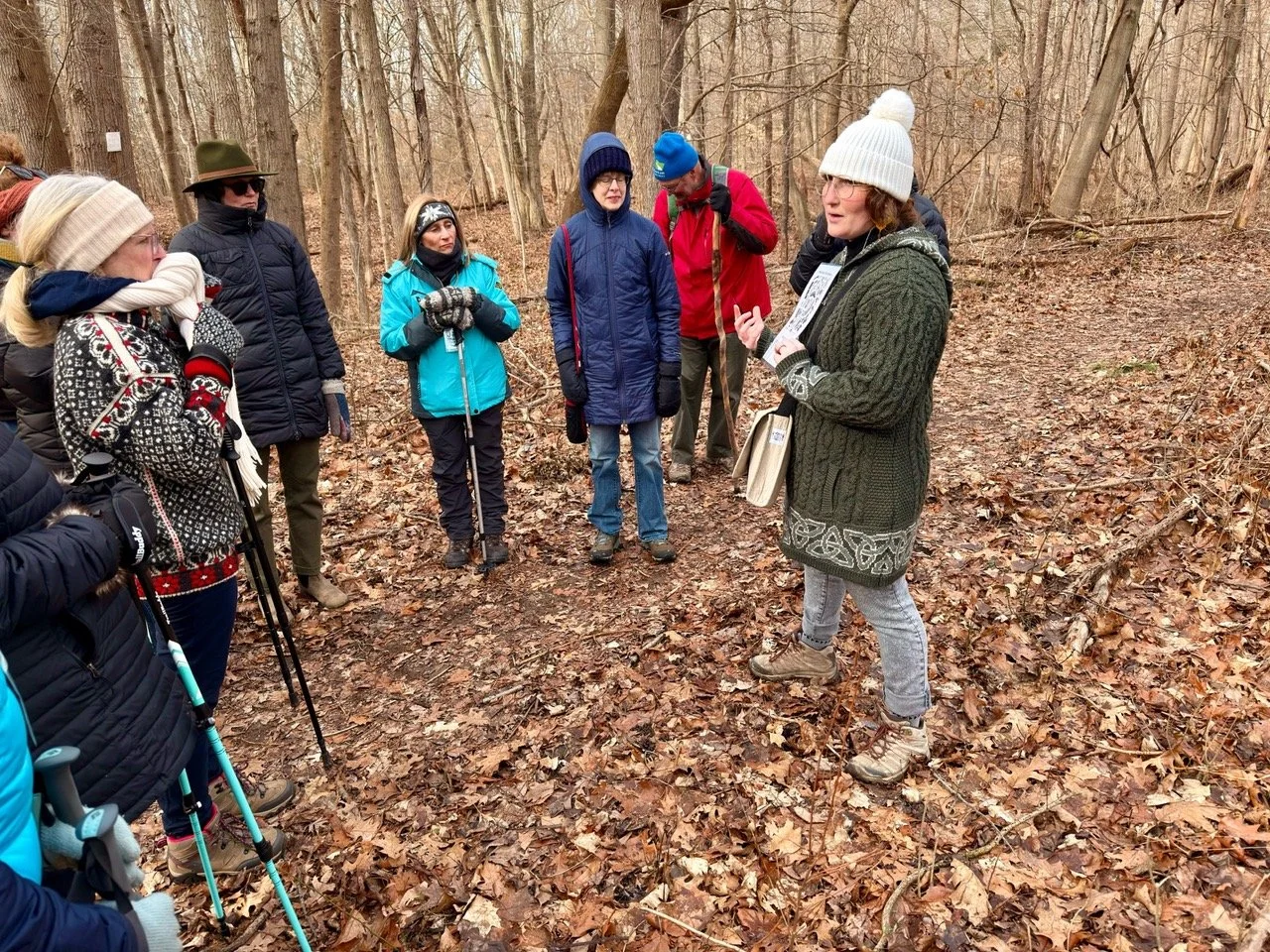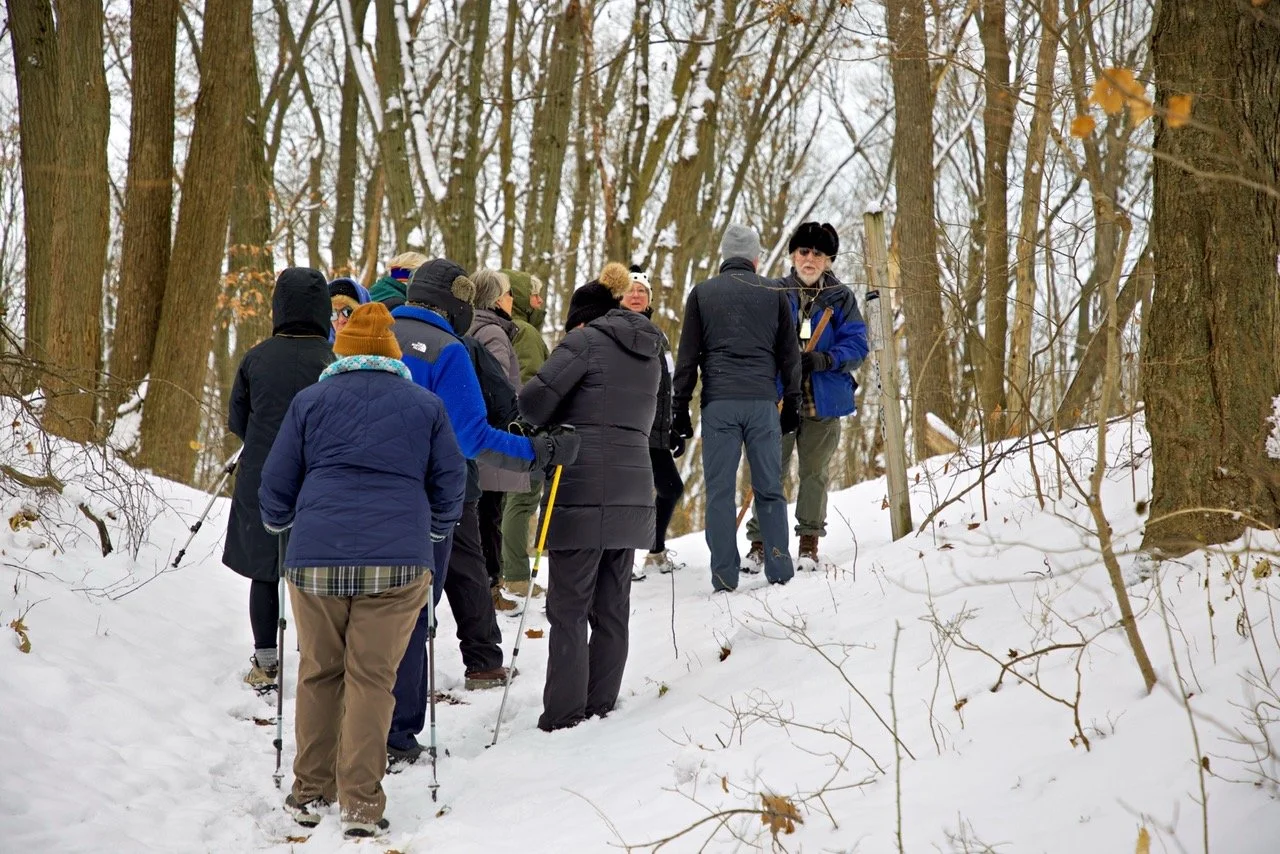Non Snow Hiking at Hoadley Nature Trail
On November 15th at 1 o’clock sharp, 15 or more hikers gathered around Pat’s Truck to learn about the pros of Snow Hiking and the extra steps you should take before and during a cold winter hike. We learned during cold, deep snow hikes you burn more calories, build muscle, boost cardiovascular health, strengthen the immune system and produce brown fat. We reviewed what brown fat is good for since it was something most of us wasn’t aware of. The mental advantages include, finding solitude and peace, enjoying unique scenery, investigating animal tracks, boosting your mood, and building confidence in yourself after a tough hike. We also reviewed dressing like an onion (layering) and the essential gear you shouldn’t leave at home. Last but not least, let someone know the “Where? When? Who? Why? What?” details of your hike.
The hike proved that the pathway to Hoadley Trail and the trail itself is a wetland. Not only did we have a good view of the engineered stormwater wetland retention, we meandered around many shallow water pools and mushy ground. We entered the east access and wowed at the amount of green leaved invasive shrubs (honeysuckle) that were easily noticed against the fall colored surroundings. Another observation was the large number of hickory trees found in the woods at Hoadley. The question was posed, can you eat the nuts? A quick search says yes. Harvest and select the nuts, Dry the nuts (air-dry or roast), Crack the nuts, Extract the nut meat, Enjoy! We stopped at a small bridge and talked about the spring streams and rivulets that run through the woods and the vernal pools that form from them. Vernal Pools are a keystone ecosystem that is a perfect landscape for developers. They are endangered for that reason. We then made our way back to the trailhead and concluded another fun hike.
A Busy Day at the Galien River County Park
On November 1st Derek Pelc, Chief Naturalist for Berrien County Parks, led a group of 40+ Harbor Country Hikers on an upland and marsh level excursion on this sunny fall day. An unexpected guest showed up for the hike, Jill Adams, the Berrien County Parks Director. This was her first HCH hike. Before we began our final Splash of Color adventure, Derek gave some park history and briefly explained some interesting facts about its unique Great Lakes Marsh. As we made our way onto the Ridge Trail, it was impossible to ignore the bright green invasive honeysuckles shrubs. We also noticed that many trees were downed from recent wind storms. A lot of freshly sawn logs lined the trail. When we reached the canopy walkway we quickly discovered the large size of our group posed a problem. The tower began to sway vigorously, enough to knock you off your feet. We paused and let half the hikers cautiously make their way to tower, then the remaining hikers joined the group. This worked out well, still some sway, but not so scary. The fall color views were great in the woods, but didn’t compare to the view from the tower. While still on the tower, HCH President shared some pre-settlement history and a chronological history of major changes that effect the marsh to this day. We made our way down the stairs and to the end of the marsh boardwalk. As we returned to the parking lot, we all agreed, a nice hike it was.
A STATUE, FRUIT LOOPS, AND BEAUTIFUL TRAILS
On October 18th we all gathered at the Madeleine Bertrand County Park in Niles, Michigan without Pat Fisher who attended a meeting of naturalists. Bob Vondale graciously took over and filled us in re: the upcoming membership meeting on October 25th from 5-9 at the Tower Hill Campground. It promises to be a lot of fun with a hike in Warren Dunes, food, guitar playing by at least one of the Weko Boys and, I imagine, anyone who wants to join in. If you have hiking ideas or simply want to enjoy yourself while getting information, you know where to be.
Yesterday’s hike was a repeat of HCH’s Berrien County Parks Fall Tour. The naturalist Lamanda Hilty, staff member at Love Creek Nature Center, led us all numbering 14 people and one enthusiastic dog. Beside one of the huge parking lots close to the Welcome Center, the bathrooms, and the disc golf course, we stood in anticipation of the colors we’d see. Little did I know that I’d also get a lesson in the particular smell of some crushed leaves. Hiking in part of one trail and part of another so that we could get close to the Saint Joseph River, we walked about 2.5 miles along wide leaf-strewn trails dotted by picnic benches. Lamanda told us that the fall colors we were seeing were the leaves’ true colors shown because of the chlorophyl depletion. She also said that the last green to go was from the invasive honeysuckle. (Sadly, she and another naturalist are the only two people eradicating invasives. When an HCH member asked about volunteers, she said she’d love the help. So, should you have some time, please contact Lamanda.)
As we enjoyed the beautiful fall weather and the respite from autumn rain that preceded and followed our hike, Lamanda plucked a sassafras leaf and crushed it. Then she passed it around. “Like citrus or fruit loops,” she said. We all sniffed and agreed. We continued to sniff as she crushed a paw paw leaf in a patch of paw paw trees. “Green pepper,” she said. We nodded our heads in surprise. She showed us the three shapes of the sassafras leaves: a football, a mitten, and a ghost. I couldn’t quite see the ghost, but I sure saw the football and mitten, and I most definitely saw the ridged potato chip look of the witch hazel leaf.
When we stood near the river, Lamanda told us of the pavilion that had once been there. Hopefully, another shelter would be built. Later, in the parking lot, we got a little history. Its name came from the Potawatomi woman who became the wife of a French fur trader, Joseph Bertrand. According to the Michigan Historic Site sign, Bertrand established a trading post on the land, and, under the 1821 Treaty of Chicago wherein much of the lower southwest corner of Michigan was ceded to the United States, Madeline Bertrand was deeded this site. It is now part of the Berrien County’s Park system. When you go, you can see the four-foot bronze statue of the woman Madeline or Nona who was raised by Potawatomi Chief Topinabee and married to Joseph Bertrand. The woman, who continued participating in Potawatomi rituals, and her husband had seven children. In 2023 the bronze statue was stolen and then returned. Tuck Langland, the original sculptor, reinstalled it on the pedestal.
Storm Damage at Love Creek
October 4, 2025
Derek Pelc, park manager and naturalist at Love Creek County Park, led a group of 20 Harbor Country Hikers on an upland excursion on this unusually warm day. Love Creek is one of Berrien Counties Hidden Gems, a place with some interesting past history, and some unfortunate recent history. Our hike took us on trails that were devastated On May 4th of this year. On that day, a wind shear came through the forest and toppled many trees like a domino run. It required new trails to get large equipment into the wind damaged areas, altering the trail map, possibly forever!
Fortunately, nature isn’t discouraged by unfortunate events. The freshly exposed ground where the big trees stood, are coming to life with bright green flora and fast growing saplings. The animals in the forest are still making their seasonal calls, the leaves are still changing to their fall colors, and the trails are now open for autumn hikes and upcoming winter recreation. Life goes on at Love Creek County Park.
Not What I Expected
We headed along trail, greeted by a host of not merely daffodils as Wordsworth saw, but a host of wildflowers. First, there was the profusion of goldenrod which, I learned, exists in over 100 U.S. species including the flat-top goldenrod (pointed out by Pat) plus the wetland’s swamp goldenrod. White and purple asters were abundant along with the purplish-pink Sweet Joe-Pye weed, the scarlet-red cardinal flower that loves moist to rich soil, the white-flowered common boneset, and the clematis virginiana or virgin’s bower. In September, its seed heads look like tufts of falling hair (most notable in female plants). Then there was the touch-me-not or jewelweed with its wonderfully orange flowers. We were explained how this plant got its two names: the first because its explosive seed capsules burst open when touched—we were too early in the season for that—and second because the watery stems and leaves are adorned with dew that looks like individual, sparkling diamonds.
To the right and left of us grew cottonwood and a few ash trees that had somehow survived the ash bore and the invasive autumn olive. We spied two dragonflies vertically lying on a tree trunk that made us wonder: Is one eating the other or are they mating? So many questions. So much beauty not to mention the fact that makes me even more cautious in my yard. While Virginia creeper has five leaves and isn’t poisonous, and poison ivy has three leaves, the latter’s leaves are varied: smooth or not, with different shapes and colors.
All in all, this venture was not at all what I expected and quite beautiful! If you live close by, visit. It’s worth it. If you need to travel a distance, it’s also worth it.
On September 20th, five of us hiked the Great Marsh Trails in Indiana Dunes National Park which is not to be confused with Indiana Dunes State Park. In 2019 the Indiana Dunes National Lakeshore was re-designated a National Park. This fact plus others was not what I expected to learn on this hike. I had foolishly never considered how wealth and politics (local and federal) have shaped the wealth of our public lands. Without Aaron Montgomery Ward Chicago’s Grant Park would have certainly succumbed to commercial development. Without Edward Warren, Warren Dunes State Park and Warren Woods may have been privatized.
The Great Marsh Trail also had twists and turns in its history unlike the straight right and left pathway that we took through it. A natural interdunal wetland, it was drained in the early 20th century for agricultural and residential purposes. Imagine a great subdivision of properties with left and right streets. As we walked along the narrow, mosquito-free trail, we saw, under our feet, blocks of concrete bricks. In 1927, a Chicago developer bought 3000 acres for what would be Beverly Shores. He sold them to his brother who began to create streets and homes, five of which were in the World’s Fair and still stand as tourist attractions. Then came the famous Wall Street crash. Acreage was neglected until 1998 when the National Park Service began restoring it. Now a thriving wetland, the Great Marsh trails are a famous habitat for breeding and migrating birds.
We did not see many birds although we heard them. On the observation deck overlooking the marsh, we saw a few swans, but what we saw was not what I expected. In fact, neither was the trip. It almost got cancelled. Pat, our fearless leader, and I stood in the rain near the trailhead. We were the first two there. It thundered. “We should cancel this,” Pat said. “Or we could go it alone.” I must have looked forlorn. I had traveled for an hour, and I wasn’t in the mood to get back in the car. We almost headed out when several cars drove up. A few minutes later, the rain stopped. After all, it was mid-September in Michigan where it either pours for hours, pours for minutes and then sputters out or rains off and on.
We headed along the trail, greeted by a host of not merely daffodils as Wordsworth saw, but a host of wildflowers. First, there was the profusion of goldenrod which, I learned, exists in over 100 U.S. species including the flat-top goldenrod (pointed out by Pat) plus the wetland’s swamp goldenrod. White and purple asters were abundant along with the purplish-pink Sweet Joe-Pye weed, the scarlet-red cardinal flower that loves moist to rich soil, the white-flowered common boneset, and the clematis virginiana or virgin’s bower. In September, its seed heads look like tufts of falling hair (most notable in female plants). Then there was the touch-me-not or jewelweed with its wonderfully orange flowers. We were explained how this plant got its two names: the first because its explosive seed capsules burst open when touched—we were too early in the season for that—and second because the watery stems and leaves are adorned with dew that looks like individual, sparkling diamonds.
To the right and left of us grew cottonwood and a few ash trees that had somehow survived the ash bore and the invasive autumn olive. We spied two dragonflies vertically lying on a tree trunk that made us wonder: Is one eating the other or are they mating? So many questions. So much beauty not to mention the fact that makes me even more cautious in my yard. While Virginia creeper has five leaves and isn’t poisonous, and poison ivy has three leaves, the latter’s leaves are varied: smooth or not, with different shapes and colors.
All in all, this venture was not at all what I expected and quite beautiful! If you live close by, visit. It’s worth it. If you need to travel a distance, it’s also worth it.
Paw Paw River County Park, September 7
Paw Paw River County Park, September 7, 2025
This was our first visit to the Paw Paw River County Park. It is a short one-mile trail and has limited parking, but 24 hikers and both dogs felt it was worth the visit. The trail tread is compacted stone so it was an easy hike. Pat Fisher, our hike leader, introduced the hike with some park and river history. Because the trails are on an island, the bridge is the trailhead. We stopped on the bridge and looked for signs of the flow control dam that was removed a little over 10 years ago. No visible evidence was found. There were plenty of enormous trees along the trail and an unusual number of sycamores. Even the sassafras trees were some of the largest we’ve seen on our hikes. And yes, there were Paw Paw trees. The trail was wide, which was a good thing since the edges were covered in poison ivy plants. Along the way Pat explained some of the importance of riparian zones for plants and animals. When we reached the eastern end of the trail we stopped and looked for remnants of the diverter dam. Again, no signs were found. We paused our hike here for a while to listen to the water flowing over the rocks and take in the beautiful scenery. On the return section of the hike, we found quite a few rusty remnants from yesteryear, one being some sort of a power transmission pole, unlike any we had seen before. The hike ended up being exactly 1.5 hours. Happy Trails.
Great Signage, Wide, New Trails, Glacial Memories
Navigating construction headaches and detours, on SaturdayAugust 23, twenty-six people accompanied by two dogs easily found room in the newly built parking lot of the Myron Perman Nature Preserve in Buchanan, Michigan. The topic of the day, led by Pat Fisher, President of HCH, was the glacial Lake Madron, first of five glacial lakes in the Berrien County, Kalamazoo, and Valparaiso morainic systems. The parking lot was the first indication of how easily accessible this new preserve is. The trails are wide and well-cared for. The signage is abundant, and, given the diversity of environment in the 45-acre preserve, we were all in for a real treat. The lack of mosquitos and the cool weather only added to our pleasure.
The history of this place is no less interesting. In 1986 a group of friends purchased the land. Myron Perman, a professional carpenter, oversaw the construction of a small house and three families owned and enjoyed the property for over three decades. In 2022, it was donated to the Southwest Michigan Land Conservancy in partnership with Chikaming Open Lands with the caveat that this beautiful place would always be enjoyed by the public. Notable is the quote on one of the historical markers: “We hope this forest will inspire others as it has inspired us and so many dear ones.”
As we walked, Pat explained another history: the glacial retreat that formed kettle lakes and drumlins throughout Michigan. The drumlin itself is an elongated hill composed of glacial deposits formed beneath an ice sheet and aligned in the direction of ice flow. Pat lovingly called the accumulating deposits “glacial poop,” and all of us got to climb the steep hills. (Pat had brought extra walking sticks for those who needed them.) Before the climb, we began the hike on flat land that was surrounded by farm fields. Inside the wetland forested area, we viewed sassafras, basswood, beech, maple, oak, wild cherry trees, and what appeared to be a vernal pool. An abundant supply of acorns had fallen. One member found the remains of a beautiful, large pale green Luna moth native to eastern North America.
While the trees around us were not immense as in Old Growth forests, some of the beech were substantial in size, and everything, minus the stinging nettle and poison ivy, dappled by sunlight and shadows, made us want to come back. A few noted that it would be hard to get lost with the signage and that you could see through the trees a good distance. As for the poison ivy, Pat also had great advice. He tightens up his pants legs by first rolling up his pant cuffs, tightening and holding them in place by using military blousing bands (rubber bands can also be used), then unrolling and tucking the cuffs into his boots. This keeps the pants tight against his boots and keeps things out such as ticks, snow or water. Since oils from poison ivy can transfer to boots, he reminded all to wash their hands after lacing an unlacing them.
Sounds of the night
Led by Lamanda Hilty, Berrien County Parks Naturalist, eight hikers explored the Galien River Saturday night August 9 looking and listening for Birds of the Night. Lamanda shared some fun facts on how these birds navigate the night, their hunting strategies, and the sounds they make. She covered the local owl sounds and answered many questions about them. Lamanda expanded her talk to include insect sounds, so we learned about, and listened to, the physics of noisy night bugs. Questions included things like herp/bird sound-alikes. Lamanda also showed us some cool things out of her show-n-tell bag.
While on the overlook, Pat Fisher explained the mechanics of Great Lake Marshes, some Lake Pottawatomie history and we watched for birds on the move. Our hike included a walk on the Marsh Boardwalk out to the river. During and after twilight, Lamanda played some bird calls. In the past, Pat’s been out with Kip Miller (retired Berrien County Naturalist) at this park and had some luck talking with the night birds. No return calls tonight though. :-(
The toads were on the move on the way back to our cars. All the hikers had a nice time. With lots of insects sounds, maybe we should have called this "Insects of the Night Hike."
Wildflowers and butterflies after the storms
The thunderstorms just ended prior to our (7 pm EDT) evening hike Saturday July 26 at Burns Prairie Preserve. While many were deterred by the rainy weather, Bob Wagner, Chikaming Open Lands (COL) Preserve Steward, led eight hikers (including three from Chicagoland) on a great hike. The preserve boasts native prairie grasses, such as bluestem and Indian grass, as well as an abundance of wildflowers, including black-eyed Susan, purple cornflower, and butterfly weed. We were also treated to Monarch, Viceroy and Papilio Glaucus butterflies feeding on the rain covered thistles. While the clouds prevented watching the sunset over the prairie, everyone had an enjoyable hike.
To see pictures from this hike, please see our Facebook page or at HCH - Burns Prairie Preserve photos
Dragonflies, mosquitoes and nettles…
Pat Fisher (HCH President) led 13 hikers on Saturday July 12 on a simple out and back hike along the Heron Rookery Trail, which follows a portion of the Little Calumet River that once featured over 100 Great Blue Heron nests. After 60 years of nesting here, the herons have moved on to new nesting grounds. These woods remain alive with dozens of birds including kingfishers, woodpeckers and a wide variety of migrating and nesting warblers.
The trail was lush with vegetation including nettles in many places that tried to grab onto legs of the hikers. Dragon flies were abundant, as they had good feeding grounds with the swarms of mosquitoes that followed the hikers on the trail. The result was a hike that had a brisker than usual pace — but the mosquitoes kept up with us. Thankfully most hikers had a good supply of repellant and we all used it liberally. The trail did feature nice spots to listen to the flowing water of the Little Calumet river, to stop to admire the variety of fungi on fallen logs near the trail and see dragon flies posing to have their pictures taken ( photos from the hike )
Merritt Family and Younger Family Preserve
Saturday, June 21
Union Pier, Mich.
Fourteen of us humans and one dog took the Merritt Family and Younger Family Preserves trail. It was a humid, hot day. We came with hats and water bottles, and we drank as we walked along a 1.3-mile loop that snaked alongside the busy I-94 highway. Before we took to walking and hydrating, Susan Ebler, a long-time steward and volunteer for Chikaming Open Lands (COL) and her husband David Ebler briefly explained the role of stewards: to walk trails periodically, alert staff to muddy areas, control invasive species, and, as they were doing, introduce others to the varied beauty of COL.
We also enjoyed learning about the history of the place. The Merritt Family first gifted 35 acres to COL. Then the Younger Family sold 25 acres to COL at a bargain price. The Merritt Family Trail, the Merritt Pond Trail, and the Younger Family Loop Trail form the 1.3-mile loop from these two properties.
It is quite amazing to see all manner of trees (large maples, sassafras, new growing ash, ironwood), to walk on the wide dirt trail with large patches of moss, to pass a forest floor full of mayapples, stand over ravines and depressions, note bird calls, while at the same time seeing the whiz of traffic and hearing the noise of I-94.
With the dog, huffing mightily beside us, we noted the slash from logging days where animals now have a protected habitat and the staging area for logs that has become a prairie with raspberries, blackberries, and various prairie plants. Pat, a repository of knowledge, pointed out the circular pin-like holes on an ironwood made by a foraging woodpecker different than the large round and rectangular holes I had learned about. He opened a gall and gave us a quick lesson on gall formation. Even before the sweating and water drinking, we also learned the important matter of safe parking, for some of the area along the road is muddy enough to stop a car in its tracks, and it is not advisable to drive as far as the dead end.
Leonard Wildlife Preserve
Saturday, February 1
Union Pier, Michigan
Our wildlife search for tracks and scat in the snow melted away as very little snow remained from a snowfall a week earlier. Hike leader Gracie Fredenburg, Chikaming Open Lands’ education and outreach coordinator, saved the day with some great handouts and plenty of discoveries in the frozen dirt and bits of snow that hadn’t melted. Grace talked about the habitats of the Leonard Preserve wildlife and why they are found there. Probably the most interesting part of the hike was in the successionary forest on the north end of the property, where we found some mosses, fungi and scat. Twenty-six people showed up for this hike. (Photo by member Mark Piper.)
Tower Hill Camp
Saturday, January 11
Sawyer, Michigan
About 30 of us met at Tower Hill Camp under a blue sky full of white fluffy clouds and temperatures right at freezing. Around 4 inches of packed snow covered everything. After learning the difference between hibernation, torpor, frogcicles and several other winter animal survival strategies, we headed down First Ave. and made our way to the local beach access trail. The snow- and partially ice-covered Painterville Creek was beautiful. Eventually, we came upon snow-covered dune grasses and an shelf ice forming on the snow-covered beach. A perfect example of an active ice volcano was waiting right in front of us and after a short walk down the beach we found huge ice balls, nearly two feet in diameter, that were still forming. After everyone had a chance to get their photos, we turned around and made our way back to the parking lot. Most of the hikers decided to continue to Tower Hill Woods. We shared the trails with cross country show skiers. All in all, it was the perfect day for a gorgeous hike. (Photo of a Lake Michigan ice ball by Greta Elizabeth Hurst.)
First Day Hike
It all begins with an idea.
Wednesday, January 1
Robinson & Flynn Woods
Three Oaks, Mich.After a light snow, temperatures stayed just below freezing and winds stayed calm for our annual First Day Hike. Twenty-two hikers showed up, and started with Robinson Woods. Half the group opted for the extension in Flynn Woods, across the street from Robinson. The Flynn Woods portion was supposed to have been a loop trail, but water on the west side of the trail had already begun pooling, so that part of the hike became, by acclaim, an out-and-back walk to keep our boots dry. Plenty to see along the way, like green mosses poking through the snow. (Photo by member Mark Piper.)
Warren Dunes State Park
It all begins with an idea.
Saturday, December 21
Sawyer, Michigan
Two inches of freshly fallen snow and partly sunny skies made for a perfect afternoon hike for the 16 people (including two newcomers) who showed up at Warren Dunes. The group had virtually the whole area around Floral Road to itself–we only encountered one other hiker. Leader Pat Fisher pointed out several girdled oak trees along the way, victims of Oak wilt, a fungal infection that is spread by beetles and is almost always fatal. Killing trees with the disease keeps it from spreading to other oaks in the forest. One hiker pointed out holes in trees made by pileated woodpeckers. Others inspected birdhouses nailed to several trees and proclaimed them homes for wood ducks. (Photo by member Mark Piper.)
Harbert Road Preserve
It all begins with an idea.
Saturday, December 7
Three Oaks, Michigan
President Pat Fisher gave a brief introduction about Michigan’s natural features, then turned hike leadership over to member Mark Piper. (A fall at home left Fisher, who was originally scheduled to lead the hike, with an uncomfortable foot injury.) Piper led the two dozen who attended through the preserve’s 90 acres of various types of wetlands, prairie and woodlands along its perimeter trail. (Photo by member Mark Piper.)
Grand Mere State Park
It all begins with an idea.
Saturday, November 16
Stevensville, Mich.
Forty-six hikers, including some new members, turned out for this November event at one of Michigan’s more diverse state parks. The park’s 1,100 acres offer two embayments, small lakes left behind by glaciers. A third, North Lake, is part of a township park and is used for recreational boating and, in season, duck hunting. The weather started out sunny, then turned cloudy, but temperatures remained comfortable. Hike leader and Hikers President Pat Fisher said there were originally five embayments, but two have dried up–and eventually the others will, too. Some unusual properties of the sand at Grand Mere make it ideal for casting car parts, and Michigan’s automotive industry fought for and briefly won rights to mine this resource. Grand Mere was designated a Natural Landmark by the National Park Service in 1968, and has many natural features not found in the rest of the state.







